Edgar de Gas (later merged by him as Degas) was born in Paris on July 19, 1834, the eldest of five children of a wealthy family. The death of his beloved mother when he was only 13 years old deeply affected him. Although he enrolled in law school, he did not continue. His father, a banker, was interested in theater and music, so he supported his son’s inclination towards art.
Degas’s younger brother Achille, a student in the Navy, later goes to America and starts working in the family’s cotton business in New Orleans. Degas also painted him with his family. The portrait is one of the paintings reflecting the painter’s first style. The influence of the French painter Jean-Auguste-Dominique Ingres, whom Degas admired, can be seen. However, the young student’s relaxed pose and gaze are unique to him. In his portraits, he reflects the person psychologically in depth. This is also seen in his later works. Between 1855 and 1865, due to his strong family ties, he painted portraits of members of his family.
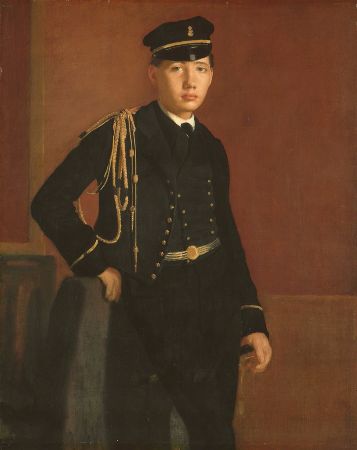
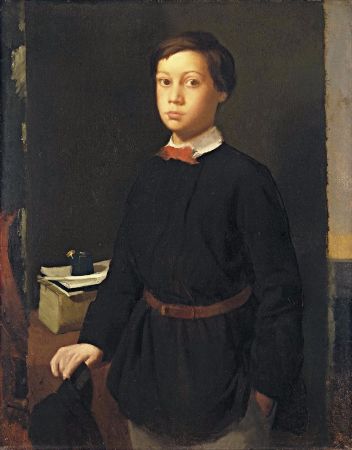
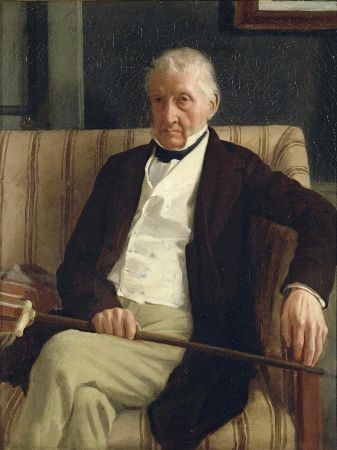
In 1852, he converted a room in his house into a studio and began working with the painter Félix-Joseph Barrias the following year. At first, he develops his knowledge of drawing by working on copies of the old masters’ works in the Louvre. In 1854, he works with the painter Louis Lamothe. Lamothe is a student of Ingres, whom he admires. In 1855, Ingres, whom he met in 1855, advised him, “Draw lines, young man. Many lines”, he advises him. In the same year, Degas is accepted to the École nationale supérieure des Beaux-Arts. He goes to Italy. There he studies academic and classical art techniques by copying the works of important Renaissance artists such as Michelangelo, Raphael and Titian. In 1859, he returns to Paris, during these years he goes to Normandy to visit his childhood friend Paul Valpinçon and during this visit he starts to paint horses.
In 1852, he converted a room in his house into a studio and began working with the painter Félix-Joseph Barrias the following year. At first, he develops his knowledge of drawing by working on copies of the old masters’ works in the Louvre. In 1854, he works with the painter Louis Lamothe. Lamothe is a student of Ingres, whom he admires. In 1855, Ingres, whom he met in 1855, advised him, “Draw lines, young man. Many lines”, he advises him. In the same year, Degas is accepted to the École nationale supérieure des Beaux-Arts. He goes to Italy. There he studies academic and classical art techniques by copying the works of important Renaissance artists such as Michelangelo, Raphael and Titian. In 1859 he returns to Paris, during these years he goes to Normandy to visit his childhood friend Paul Valpinçon and during this visit he starts to paint horses.
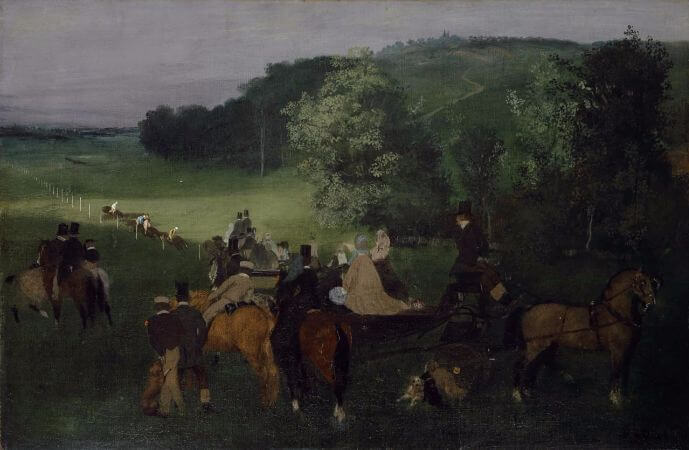 Edgar Degas, At The Racecourse, 1862
Edgar Degas, At The Racecourse, 1862
At The Racecourse (The Races), (Sur le champ de courses (Les Courses), 1862
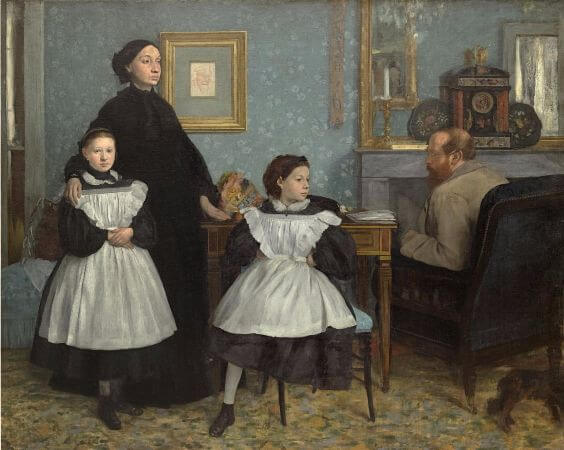 Family Portrait (also called The Bellelli Family), 1867
Family Portrait (also called The Bellelli Family), 1867
For this family portrait, Degas spent five years making sketches. His aunt Laura de Gas married Baron Gennaro Bellelli in 1842 and gave birth to their daughters Giovanna (left) in 1849 and Giulia in 1851. In the painting, the facial expressions of all four show the individuality and attitude of each of them. The Baron sits with a stern profile with his back turned to the viewer, while Giulia sits quietly with her left foot beneath her. The Baroness and her eldest daughter stand in poses reminiscent of the well-known artists Holbein and Clouet. The large black, brown and white geometric shapes of the armchairs, tables, dresses and aprons are balanced by floral carpets, wallpaper and ornaments. The reflections in the mirror add interest and confusion to the composition.
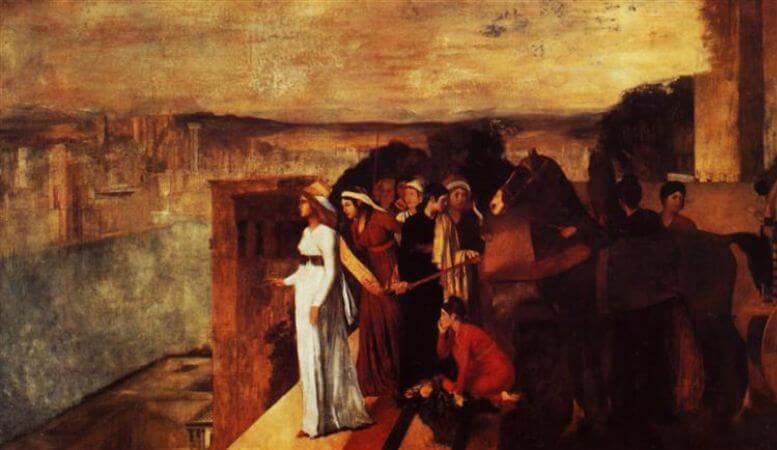 Edgar Degas, Semiramis Building Babylon, 1861
Edgar Degas, Semiramis Building Babylon, 1861
In 1865, he leaves historical subjects aside and concentrates on portraits. He establishes a friendship with Édouard Manet. Manet introduces Degas to the painters who will be known as impressionists in the years to come. All these painters gathered at the Café Guerbois in Paris. He also started to frequent the same café. Although Degas shared most of Manet’s views, he stayed away from the Impressionists. They leaned towards light and vivid colors. Degas, who adheres to the balance and logic of the old masters, seeks immutability and eternity in people and things.

In 1863, Degas’s sister Thérèse married her cousin Edmondo Morbilli, who lived in Naples. This sumptuous portrait was probably painted during the couple’s visit to Paris after the loss of an expected child in early 1864. Thérèse sits in the shadow of her husband, who has a cool, dull, calm expression, as if taking refuge with her, and a worried expression. Blacks are placed among the gray tones of her dress, the tablecloth with Islamic figures is almost the same color as Edmondo’s jacket and chair. The most skillful and clever of his portraits, this work is reminiscent of Renaissance paintings.
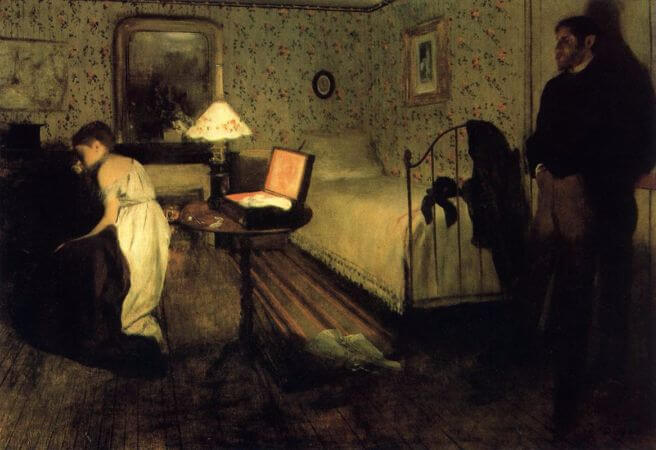 Interior (The Rape), 1869
Interior (The Rape), 1869
A bedroom with a floral wallpaper, the man’s coat is on the edge of the bed, the woman is sitting sadly in a chair with her dress stripped off and her corset on the floor. The light in the center of the room is used dramatically. On the coffee table is a sewing box that looks like an open suitcase. The painting looks like a couple after a fight scene. This painting was called Rape 35 years after it was painted. For reasons such as the man being the dominant figure in the room, his gaze on the woman, the woman’s posture and clothes, and the open sewing box on the coffee table symbolizing the loss of virginity, it is interpreted that the work depicts a rape scene. Some critics also say that this painting was inspired by Emile Zola’s Thérèse Raquin.
Degas participated in the Franco-Prussian War (1870-71) as an artilleryman during the siege of Paris, and fell ill with a severe cold during the war. After the war, he goes to New Orleans with his brother René in 1872. He stays there until April 1873. He paints his famous Cotton Office in New Orleans.
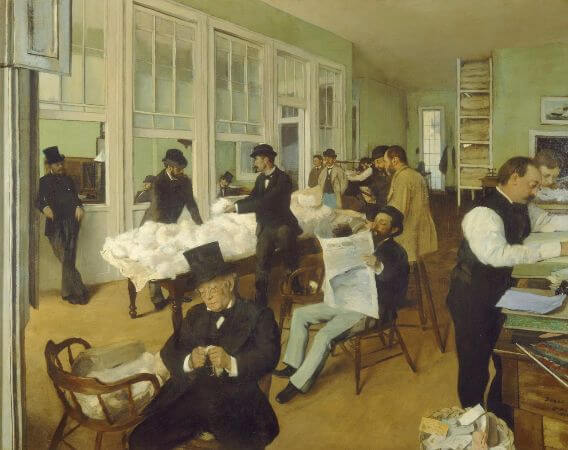 A Cotton Office In New Orleans (Un Bureau de Coton à La Nouvelle-Orléans), 1873
A Cotton Office In New Orleans (Un Bureau de Coton à La Nouvelle-Orléans), 1873
In the foreground, the old man in the hat checking cotton is Michel Musson, Degas’s uncle. Leaning against the window on the far left is Achille de Gas, the painter’s brother. The person in green pants reading a newspaper is René de Gas, Degas’s third brother. The bright whiteness of the cotton, the newspaper and the sleeve caps contrasts vividly with the dark clothes of the merchants. Irregular shapes bring variety to the composition, symbolizing the triumph of classical, linear, perspective. The windows of the outer office become smaller as they recede into space, the people in the foreground contrasting with the smaller, less prominent people in the background. These and other details inevitably lead the viewer’s eye along a diagonal axis from the view of his uncle to the empty whiteness of the window at the rear end. We see Degas’s meticulous impressions and striking talent for drawing in this almost photorealistic work.
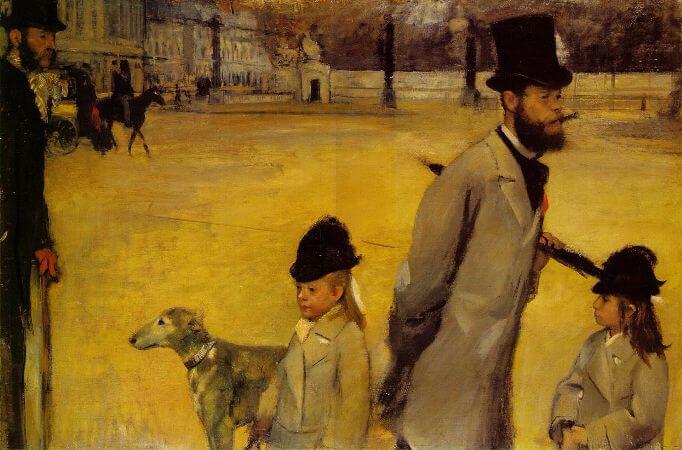 Edgar Degas – Place de la Concorde – 1875
Edgar Degas – Place de la Concorde – 1875
Degas depicts a scene of Parisian life in which urban life plays an active role. The figures in the painting are the writer Ludovic Halévy, the artist Ludovic-Napoléon Lepic and his two daughters. They are crossing the Place de la Concorde behind the stone wall of the Tuileries Palace. Degas depicts movement in several different directions. While their father is unhurriedly going in one direction, his two daughters are completely independent, looking in a different direction. In addition to critics who say that Ludovic-Napoléon Lepic’s hat and the statue in the background had a political meaning for France at the time and that Degas wanted to express this, there are also those who say that Degas painted the painting at a time when he was interested in photography and this was reflected in the painting.
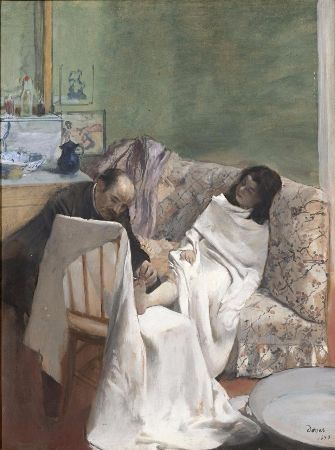
In the painting, the silvery wink of the vehicle driven by the male figure draws our eye’s focus to where the middle-aged man is working with a sleepy young thumb. The girl in the painting is Degas’ ten-year-old nephew Joe Balfour. Despite its subject, the painting draws us in with its cozy interior arrangement, blue marble, framed mirror, pitcher and blue and white sink. The sumptuous color and texture of the green background wall, the sharp slant of light from the unseen window on the right, the sensual drape of white fabric and the tilt of the man’s head over Joe’s foot also serve as soothing elements in the painting.
Returning to France from the USA, Degas exhibited his paintings in his first exhibition on April 15, 1874, together with the Impressionists, although their understanding of art did not match. The exhibition received a great reaction. The critics did not beat up Degas alone. But in his second exhibition opened two years later, Albert Wolff, one of the famous art critics, wrote the following in Le Figaro Newspaper.
“Try telling Mr. Degas that he is wrong. Tell him that there are certain qualities in art called pattern, color, creation, will. He will laugh in your face and call you a reactionary.”
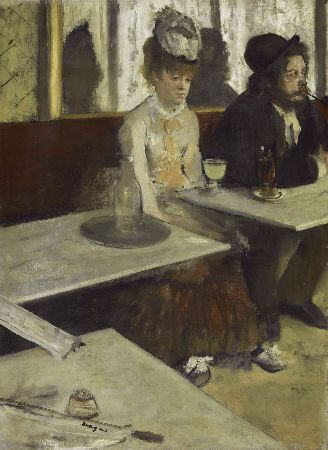 In A Café (The Absinthe Drinker), (Dans un Café (L’absinthe)), 1876
In A Café (The Absinthe Drinker), (Dans un Café (L’absinthe)), 1876
L’Absinthe, showing a couple drinking in a bar, was considered an attack on Victorian morality at the time it was made. Absinthe is a drink high in alcohol that causes hallucinations. When it was exhibited in 1892, it provoked cries of “Is there no one to paint but these vile and vulgar people?”, “It makes our beautiful France look like it is full of alcoholics”, “He has painted a prostitute and a drunkard”. The fact that the models in the painting are the actress Ellen Andre and the bohemian painter Marcellin Desboutin increases interpretations and speculations.
Degas’ aim in this painting is to capture a realistic moment from everyday life rather than social criticism. Degas shows a woman, who is described as a prostitute in the painting, resting her heels, resting the front sole of her feet, which hurts the most when she wears high heels, looking at a fixed point with empty eyes, leaving her hands comfortably in her lap, and a man smoking his pipe, absent-mindedly, but with eyes reddened by drink, looking around and the shadows of the figures. Absent is a painting of loneliness, depicted with extraordinary realism, showing how distant two people standing side by side are from each other in their own troubles. Its trademark and the feature that has caused it to be talked about so much is that by placing the figures in a forward position and drawing most of the empty bar, it makes you feel that it wants to say much more than it actually shows.
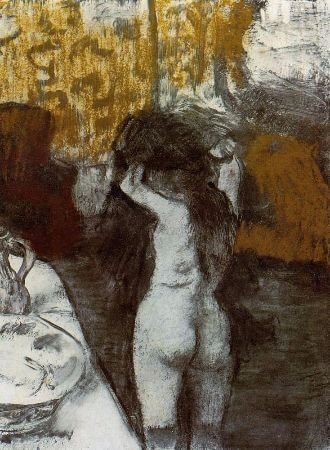 Edgar Degas – After The Bath I – 1877
Edgar Degas – After The Bath I – 1877
Degas abandoned the academic drawings of his youth and developed a whole new repertoire of erasure, scratching, fingerprinting and paint-lifting, which would later become his signature. This was monotype, a graphic technique he had met and passionately embraced in the 1870s. It is a method of drawing with black ink on a metal plate and pressing it onto paper, resulting in a single print. There are also monotype prints in which Degas used oil paint instead of ink. The artist saw the monotype as the perfect medium to convey the nature of changing contemporary urban life.
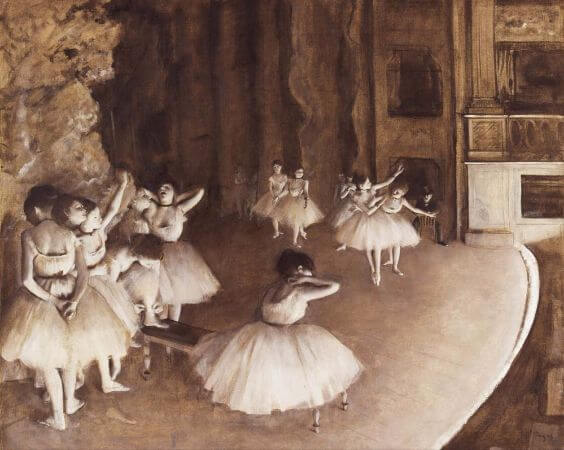
Gesture, grace, color and movement, which reveal the essence of ballet, are the characteristics that fascinated Edgar Degas, whose works are close to both realism and impressionism movements, throughout his artistic life. In the late 1860s, when Degas became interested in ballet, he lived close to Le Peletier Street, where the Paris Opera House was located. The artist, who had been a regular at the opera since his youth, was also helped by his musician friends. The artist was able to sit and work in the audience seats as well as attend rehearsals.
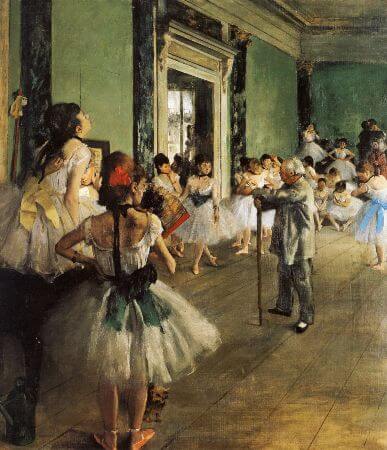 The Dance Class, 1874
The Dance Class, 1874
In addition to going as a spectator, Degas regularly visited the backstage and dance studio of the Paris Opera House, where he met a friend who played in the orchestra. At the time, the opera was still located in Le Peletier Rue and had not yet moved into the building designed by Garnier. From the 1870s until his death, Degas’ favorite subjects were ballerinas at work, in rehearsal or at rest. He tirelessly explores the theme, which includes many variations in posture and stance. It was the training and rehearsals that interested him more than the stage performance and the focus of his attention.
In this painting, the class is coming to an end, the students are exhausted, yawning, adjusting their hair, clothes, earrings or ribbons, paying little attention to their teacher Jules Perrot, a ballet master in real life. Degas closely observes the ballerinas’ most spontaneous, natural, ordinary gestures, the pauses when concentration wanes, and the changes in their bodies after intense exercise. The slightly elevated perspective, looking diagonally across the studio, enhances the lost perspective of the floor panels. Paul Valéry writes the following: “Degas is one of the few painters to give real importance to the ground, and he has some admirable grounds.” The parquet, specially prepared to prevent the dancers from slipping, also gains importance in Degas’s painting as it is the main working tool. He depicted the parquet in detail in the painting.
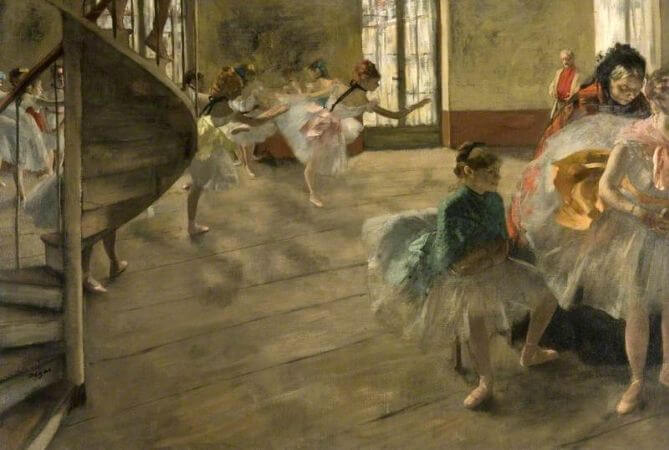 The Rehearsal, 1874
The Rehearsal, 1874
He mostly used his memory and sketches to create his paintings. The dominant structural element in this work is the spiral steps inspired by the wooden staircase Degas built to study perspective. The ladder is placed to the left of the composition, while the human figures are distributed asymmetrically. The sunlight illuminating the studio gives the pink, blue, light yellow and purple colors of the tutus a transparent, bright quality. The fully detailed figures are the ballet student and the old woman in the foreground, wrapped in a bluish-green shawl. The young bodies of the ballerinas in the background are indistinct. Although his name is mentioned among the Impressionists, he is not an Impressionist, for example, he is not interested in landscapes except as backgrounds. He used an unusual point of view in his paintings, breaking up shapes to give them a spontaneous appearance.
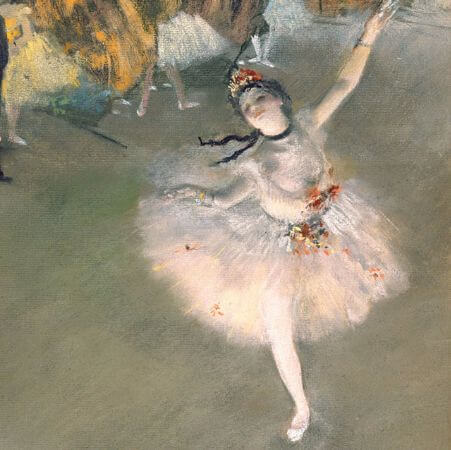 The Star, 1878
The Star, 1878
Degas, who knew classical ballet very well, portrayed many movements of this dance tradition in his paintings and sculptures.
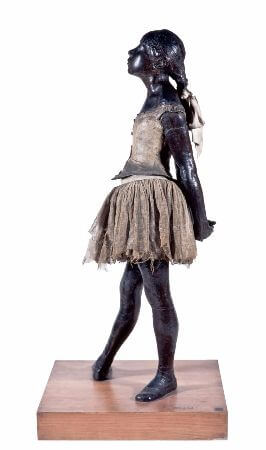 The Little Fourteen-year-old Dancer, (La Petite Danseuse de 14 ans), 1881
The Little Fourteen-year-old Dancer, (La Petite Danseuse de 14 ans), 1881
The statue of the 14-year-old little dancer is perhaps Edgar Degas’ most talked about work. Some people said that the sculpture resembled a monkey. The fact that art lovers at the time were accustomed to sculptures made of dark bronze or white marble also played a role in the dislike of the sculpture. Although the fact that he dressed his wax figure in a real tutu and ballet slippers, a wig made of horsehair and a satin ribbon was met with surprise, in later years cubist, surrealist and late 20th century artists were influenced by this feature of the sculpture. The model in the sculpture is ballet student Marie Genevieve van Goethem.
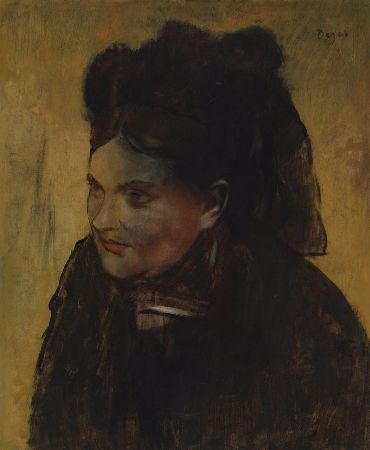 Portrait Of A Woman, 1880
Portrait Of A Woman, 1880
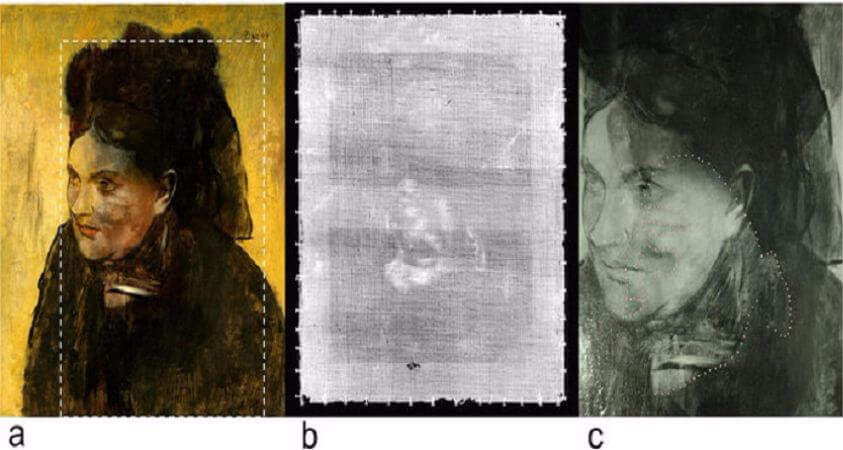
Underneath Degas’s Portrait of a Woman, another hidden portrait is discovered. Australian scientists scanned the work, on display at the National Gallery of Victoria in Melbourne, using a high-resolution X-ray technique called synchrotron, and discovered that there was a portrait of another woman underneath. The portrait hidden underneath is believed to be of Emma Dobigny, one of the painter’s favorite models. During the scanning, it is seen that Degas first drew the ears of the woman in the portrait in an upward-pointing shape, and then erased the pointed parts.
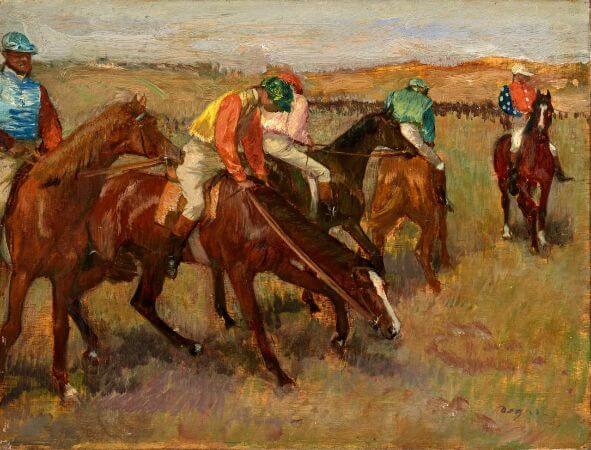 Before The Race, 1882
Before The Race, 1882
His paintings of Parisian night cafes, bars, belly dancers, ballerinas and dancers, jockeys and racehorses, full of people, are like a solid bridge between tradition and innovation. Degas, more than half of whose works throughout his life consisted of dance-themed paintings, painted jockeys and racehorses with the same passion. Lush green meadows, spectators, horse-drawn carriages, jockeys and race horses…
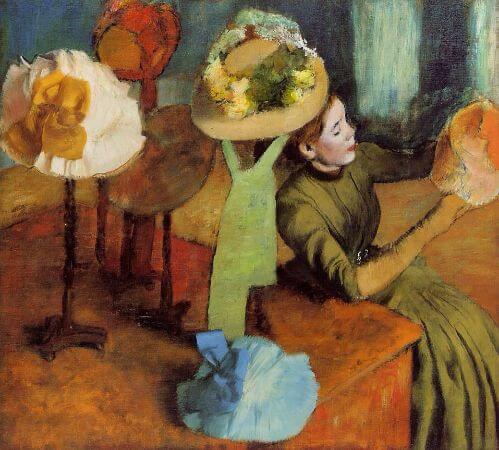 The Millinery Shop, 1886
The Millinery Shop, 1886
He depicted the painting from an unusually oblique point of view. A young girl with a needle in her mouth, gloves in her hands to protect the delicate fabric of the hat, examining the hat, seems unaware of the viewer. Degas created a contrast with the hats on the left while creating the impression of movement in the hat and the young girl’s hands with his painting technique.
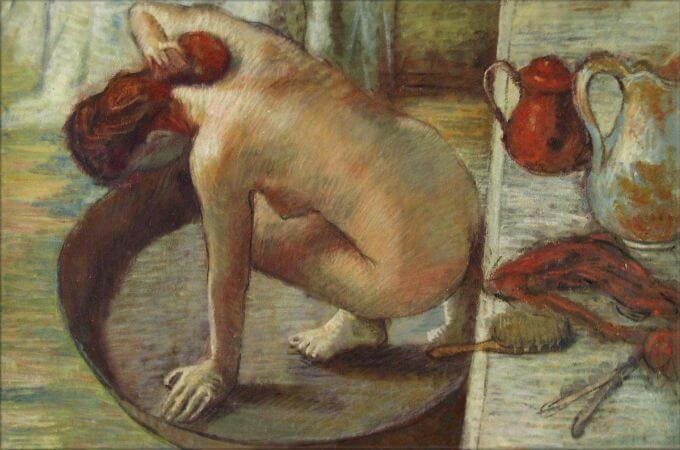 The Tub, 1886
The Tub, 1886
Degas was the first artist to make urban life the subject of his paintings. In his drawings, the artist depicts scenes from cafes, brothels, nightclubs and theater. Although he worked on subjects including ballerinas, acrobats, singers, musicians and laundresses, we see ballerinas, horses and nudes the most in his works. Edgar Degas is one of the artists who influenced the French painter Henri de Toulouse-Lautrec the most. Some of his paintings are even quite similar.
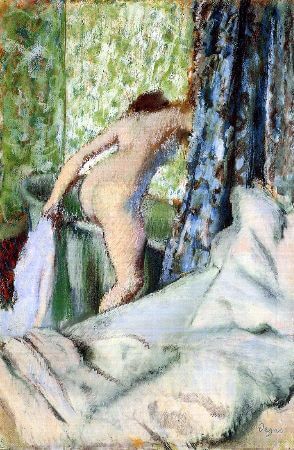 The Morning Bath, 1890
The Morning Bath, 1890
After his eighth and last Impressionist exhibition in 1886, Degas does not send his works to group exhibitions. The problem with his eyes, which were bothering him, increased and he was forced to turn to the pastel technique, which was easier to work with.
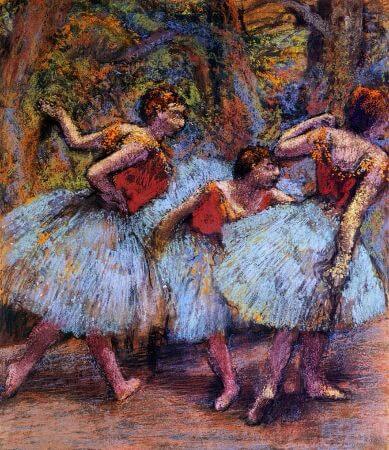 Three Dancers, Blue Skirts, Red Blouses, 1903
Three Dancers, Blue Skirts, Red Blouses, 1903
After 1890, his eyesight deteriorated and in 1908 he began to lose his sight and even partially his hearing. He had to give up painting altogether. This made Degas a moody, irritable, sullen person. He never married or had a relationship with a woman, and although there were rumors that he was a misogynist, the most elegant ballerinas came to life in his paintings.
Degas passed away on September 27, 1917 and was buried in Montmartre cemetery. Because of the war, no one but a few friends were present at his funeral.
edgar degas, edgar degas ballerinas, edgar degas works, edgar degas life, who is edgar degas, edgar degas pictures, edgar degas paintings, edgar degas life

